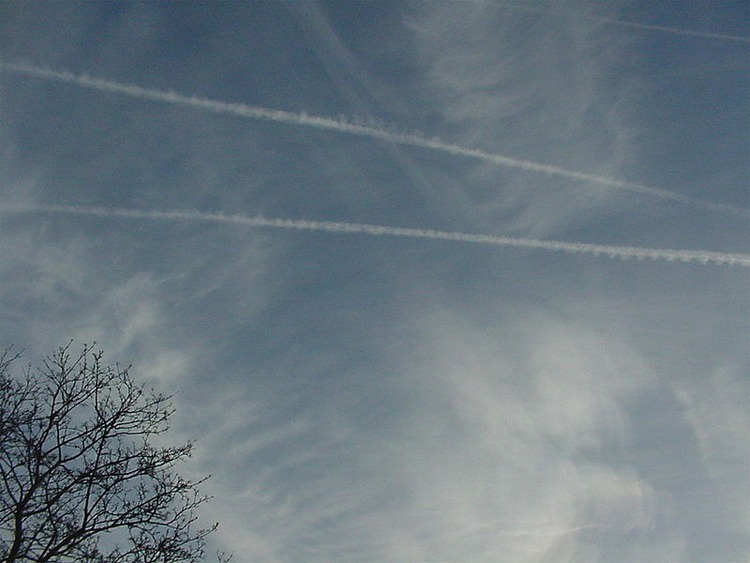Perhaps, we all had experienced from our childhood, watching a jet plane passing in the sky and leaving that white line. On a sunny weather, up on a clear blue sky, the wispy white trails are a beautiful view whether you are on an air trip or on land.
Contrails are shortened term for condensation trails. These trails are formed out of vapors produced by aircraft engine exhaust or air pressure changes, typically at aircraft cruise altitudes several miles above the Earth’s surface. These unique clouds are primarily a mixture of water vapor from aircraft engine exhaust, and the low ambient temperatures that exist at high altitudes allows the formation of the trails.
We usually think that contrails are just dirty streams of pollutants billowing out of airplanes as they cross the sky; they are mostly just ice crystals. Since water vapor is already present in the atmosphere, when the extra vapor from the airplane exhaust rapidly saturates already moist air, the water condenses and freezes into minute ice crystals.
Most commercial jet planes fly at 26 000 ft or beyond. The temperatures are freezing at those altitudes, making the large volumes of condensed vapor freezes quickly that instantly form these contrails, unlike when airplanes at lower heights aren’t going to create these clouds because the temperature is low enough. Meanwhile, low-flying planes at airshows often generate similar to contrails but are simply special effects created by smoke. Some aircraft may produce contrails that spiral out behind each wing when the humidity is high.
The engine’s exhaust produces some impurities from the fuel, which includes sulfur. This gives off some of the particles that can be the sites of water droplets’ growth. Water droplets form; they might freeze to form ice particles that compose a contrail. The changes in air pressure in wingtip vortices can trigger the formation of contrails. Their formation can also be triggered by air pressure changes in wingtip vortices or the air over the entire wing surface. Contrails and other clouds formation caused by human activities are collectively named homogenitus.
The varying humidity and temperature in the atmosphere affect the formation of contrail clouds. That is why some are visible only for a few seconds or minutes, but some may persist for a couple of hours and spread that resemble cirrus altocumulus clouds.
Scientists are interested in studying these persistent contrails as they increase the cloudiness of the atmosphere, resulting in the other formation of clouds described as homomutatus, that may resemble cirrus, cirrocumulus, or cirrostratus. They are also called cirrus aviaticus, which are suspected to influence the global climate.
Scientists interest to study the effects of contrails
The study of contrail clouds doesn’t only interest weather forecasters, but also researchers and scientists as they need to analyze both to understand whether these special clouds have a warming or cooling effect in Earth’s atmosphere, or what they call the net radiative effect.
Clouds up in the atmosphere are not just for our eyes to enjoy, but they also perform dual roles. The white cloud tops serve as mirrors that reflect incoming sunlight into space and promoting a cooling effect. Clouds also function like a blanket that traps the heat emitted from Earth’s surface, inducing a warming effect.
Airplanes, contrails, and the atmosphere
Next time you see a jet plane up in the sky, you will know why the white lines of clouds are coming from. It has the same reason why sometimes you can see your breath, especially when you are in a frigid environment.
Some researchers from the Science Systems and Applications Incorporated (SSAI) and NASA’s Atmospheric Science Data Center (ASDC) studied the contrails and include only the persistent types that are long enough to be visible in satellite data yet maintained a linear shape.
Satellite data from the Moderate Resolution Imaging Spectroradiometer (MODIS), an instrument aboard NASA’s Aqua satellite, were collected and analyzed. The detection algorithm yielded a matching result to known flight paths.
The researchers discovered that contrails have an overall warming effect. Yet, it is still relatively smaller than all the human-made radiative forcing and all humans’ activities that involve carbon dioxide and other emissions.
Additionally, they reported that the environment in which the contrails occurred, such as other clouds in the atmosphere or Earth’s surface itself, significantly influences a contrail’s net radiative effect. Likewise, contrails that form within clear skies over a hot desert or warm low clouds will have a much more significant radiative effect.


